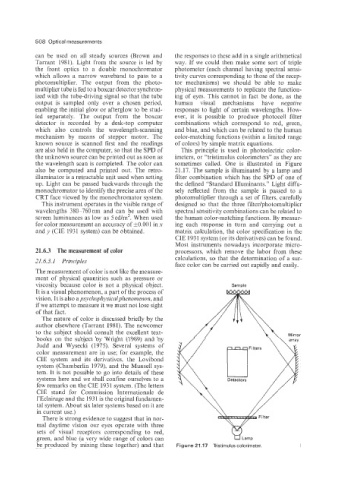Page 525 - Instrumentation Reference Book 3E
P. 525
508 Optical measurements
can be used on all steady sources (Brown and the responses to these add in a single arithmetical
Tarrant 1981). Light from the source is led by way. If we could then make some sort of triple
the front optics to a double monochromator photometer (each channel having spectral sensi-
which allows a narrow waveband to pass to a tivity curves corresponding to those of the recep-
photomultiplier. The output from the photo- tor mechanisms) we should be able to make
multiplier tube is fed to a boxcar detector synchron- physical measurements to replicate the function-
ized with the tube-driving signal so that the tube ing of eyes. This cannot in fact be done. as the
output is sampled only over a chosen period, human visual mechanisms have negative
enabling the initiaI glow or afterglow to be stud- responses to light of certain wavelengths. How-
ied separately. The output from the boxcar ever, it is possible to produce photocell filter
detector is recorded by a desk-top computer combinations which correspond to red, green,
which also controls the wavelength-scanning and blue, and which can be related to the human
mechanism by means of stepper motor. The color-matching functions (within a limited range
known source is scanned first and the readings of colors) by simple matrix equations.
are also held in the computer, so that the SPD of This principle is used in photoelectric color-
the unknown source can be printed out as soon as imeters, or “tristimulus colorimeters” as they are
the wavelength scan is completed. The color can sometimes called. One is illustrated in Figure
also be computed and printed out. The retro- 21.17. The sample is illuminated by a lamp and
illuminator is a retractable unit used when setting filter combination which has the SPD of one of
up. Light can be passed backwards through the the defined “Standard Illuminants.” Light diffu-
monochromator to identify the precise area of the sely reflected from the sample is passed to a
CRT face viewed by the monochromator system. photomultiplier through a set of filters. carefully
This instrument operates in the visible range of designed so that the three filter/photomultiplier
wavelengths 380-760nm and can be used with spectral sensitivity combinations can be related to
screen luminances as low as 5 cd/m2. When used the human color-matching functions. By measur-
for color measurement an accuracy of 10,001 in x ing each response in turn and carrying out a
and y (CIE 1931 system) can be obtained. matrix calculation, the color specification in the
CIE 1931 system (or its derivatives) can be found.
Most instruments nowadays incorporate micro-
21.6.3 The measurement of color processors, which remove the labor from these
21.6.3.1 Principles calculations, so that the determination of a sur-
face color can be carried out rapidly and easily.
The measurement of color is not like the measure-
ment of physical quantities such as pressure or
viscosity because color is not a physical object. Sample
It is a visual phenomenon, a part of the process of
vision. It is also ays~c~iophi,sicnlpheiiomenoli, and
if we attempt to measure it we must not lose sight
of that fact.
The nature of color is discussed briefly by the
author elsewhere (Tarrant 198 1). The newcomer
to the subject should consult the excellent text-
books on the subject by Wright (1969) and by
Judd and Wysecki (1975). Several system of
color measurement are in use; for example, the
CIE system and its derivatives, the Lovibond
system (Chamberlin 1979), and the Munsell sys-
tem. It is not possible to go into details of these
systems here and we shall confine ourselves to a
few remarks on the CIE 1931 system. (The letters
CIE stand for Commission Internationale de
1’Eclairage and the 193 1 is the original fundamen-
tal system. About six later systems based on it are
in current use.)
There is strong evidence to suggest that in nor-
mal daytime vision our eyes operate with three
sets of visual receptors corresponding to red,
green. and blue (a very wide range of colors can \dLarnp
be produced by mixing these together) and that Figure 21.17 bistimulus colorimeter.

